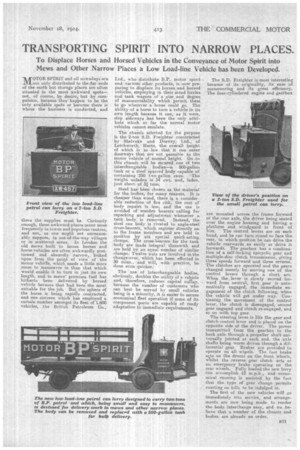TRANSPORTING SPIRIT INTO NARROW PLACES.
Page 15

If you've noticed an error in this article please click here to report it so we can fix it.
To Displace Horses and Horsed Vehicles in the Conveyance of Motor Spirit into Mews and Other Narrow Places a Low Load-line Vehicle has been Developed.
MOTOR SPIRIT and oil nowadays are not only distributed to the.far ends of the earth but storage places are often situated in the most awkward spots— not, of course, by desire, but by compulsion, because they happen to be the only available spots or because there is where the business is conducted, and there the supplies must be. Curiously enough, these awkward places occur most frequently in towns and populous centres, and not, as one might not unreasonably suppose, in out-of-the-way villages or in scattered areas. In London the old mews built to house horses and horse-vehicles are often awkwardly positioned and absurdly narrow, looked upon from the point of view of the motor vehicle, whichneeds a little more room to manoeuvre in than that which -would enable it to turn in just its own length, and to mews' premises fuel has hitherto been delivered by horsed vehicle because that had been the most suitable for the job. But the sphere of the horse is being rapidly contracted, and one concern which has employed a certain number amongst its fleet of 1,600 vehicles, the British Petroleum Co., Lilt, who distribute B.P. Motor spirit and various other products, is now preparing to displace its horses and horsed vehicles, employing in their stead lorries and tank wagons of a .sizes and degree of manceuvritlaility which permit them to go wherever a horse could go. The ability of a horse to turn a. vehicle in its own length because it can, as it were,
• step sideways has been the only attribute which so far the normal motor vehicles cannot emulate.
The chassis selected for the purpose is the 2-ton S.D. Freighter constructed by Shelvoke and Drewry, Ltd., of • Letchworth, Herta, the overall height of which is so low that it can enter doorways that are not passable to the motor vehicle of normal height. On .to this chassis will be secured one of two 'interchangeable bodies—a 500-gallon tank or a steel sparred body capable of containing 250 two-gallon cartS. The weight unladen is 34 cwt. and, laden, just short of 3 tons.
Steel has beenchosen as the material for the bodies, for many reasons. It is cheaper than wood, there is a consider. able reduction of fire risk, the cost of body repairs is less, and the use is avoided of wooden bearers calling for repacking and adjustment whenever a tank body is removed. Instead, the steel can body is riveted to angle-steel cross-bearers, which register directly on to the frame members and are held in position by six special quick-acting clamps. The cress-bearers for the tank body are made integral therewith and are held by an equal number of similar clamps. Twelve nuts are involved in the change-over, which has been effected in 30 coins., and will, with practice, be done even quicker.
The use of interchangeable bodies, obviously, doubles the utility of a vehicle and, therefore, reduces capital oullay, because the number of customers who can best be served by small vehicles being in a minority, it is easier to secure economical fleet operation if some of its component parts are capable of ready adaptation to immediate requirements. The S.D. Freighter is most interesting because of its originality, its ease of manoeuvring and its great efficiency. 'The four-cylindered engine and gearbox
are mounted across the frame forward of the rear axle, the driver being seated over the engine housing and having a, platform and windguard in front of him. The control levers are on each hand, and he can turn round to face the rear, in which position he can drive the vehicle rearwards as easily as drive it forwards. The gearbox has a combination of a self-locking epicyclic gear and multiple-disc clutch transmission, giving three speeds forward and three reverse. The clutches are operated and the gears changed merely by moving one of the control levers through a short arc. When the , lever is slowly moved forward from neutral, first gear is automatically engaged, the immediate engagement of the clutch following, when the vehicle will get under way. Continuing the movement of the control lever, the clutch is disengaged, second gear engaged and clutch re-engaged, and so on with top gear.
The steering lever is like the gear and clutch control lever and is placed on the opposite side of the driver. The power transmitted from the gearbox to the back axle through a propeller shaft universally jointed at each end, the axle shafts being worm driven through a differential gear. Brakes are provided to operate on all wheels. The foot brake acts on the drums on the front wheels, Whilst the reverse gear clutch acts as an emergency brake opgrating on the rear wheels. Fully loaded the new lorry can accomplish 12 m.p.h., and economical running is assisted by the fact that the type of gear change permits coasting on hills to be indulged in.
The first of the new vehicles will go iiiimediately into service, and arrangements are now being made, to render the body. interchange easy, and we believe that a number of the chassis and bodies are already on order.
































